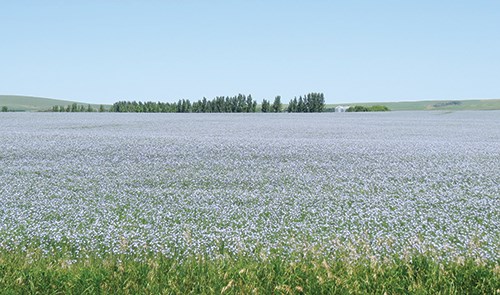With crops maturing in the field, producers are worried the record high temperatures in July will prove damaging. They have now turned their attention to haying. Haying is progressing in the province as livestock producers now have 19 per cent of the hay crop cut and 10 per cent baled or put into silage, Saskatchewan Agriculture reported for the period ending July 3. Hay quality is rated as eight per cent excellent, 54 per cent good, 29 per cent fair and nine per cent poor. Pasture conditions are rated as six per cent excellent, 38 per cent good, 41 per cent fair, 13 per cent poor and two per cent very poor.
Most of the province received minimal rain this past week, ranging from negligible amounts in most areas to 78 mm in the Nipawin area. Many areas remain dry and producers are hoping for rainfall to boost crop development and hay and pasture growth. Across the province, topsoil moisture on cropland is rated as five per cent surplus, 49 per cent adequate, 37 per cent short and nine per cent very short. Hay land and pasture topsoil moisture is rated as five per cent surplus, 40 per cent adequate, 38 per cent short and 17 per cent very short.
Overall, crops are at their normal stages of development for this time of year. Some crops are behind due to moisture issues, including 26 per cent of fall cereals in the dough stage, while nine per cent of spring cereals are in the heading stage. According to crop, two per cent of flax, 30 per cent of canola and mustard and 37 per cent of pulse crops are flowering.
One year ago, crops were developing rapidly due to optimal growing conditions with 34 per cent of cereals heading and the other crops had more than 50 per cent in flower. Over 90 per cent of the agricultural area had surplus to adequate topsoil moisture conditions, while 18 per cent of the hay had been cut and 11 per cent baled or put into silage.
Provincially, producers by early July were wrapping up in-crop herbicide applications in most areas and starting to apply fungicides. While dry conditions are causing crop stress in most areas, particularly in the south, some areas in the north have issues with wet conditions. Crop damage this week was attributed to dry conditions, wind, insects, localized flooding and hail. Producers have been busy haying, scouting for disease and insects, hauling grain, fencing and repairing equipment. SaskPower received eight reports of farm equipment coming in contact with power lines this week, totaling 37 in June and 176 so far in 2017.
In southwestern Saskatchewan, haying is underway and livestock producers now have 30 per cent of the hay crop cut and 20 per cent baled or put into silage. Hay quality is rated as four per cent excellent, 48 per cent good, 44 per cent fair and four per cent poor. Pasture conditions are rated as one per cent excellent, 16 per cent good, 65 per cent fair, 14 per cent poor, and four per cent very poor. The region received very little rain this past week, ranging from negligible amounts in most areas to 15 mm in the Limerick area. The Moose Jaw area, which received 5 mm this past week, held the record for the most precipitation, 125 mm, in the region since April 1. Many areas remain dry and producers are hoping for rainfall to boost crop development and hay and pasture growth.Â
Of the fall cereals, five per cent are in the dough stage, while 17 per cent of the spring cereals are in the heading stage. Three per cent of the flax, 52 per cent of the canola and mustard and 44 per cent of the pulse crops are flowering.
Across the southwest, topsoil moisture on cropland is rated as 24 per cent adequate, 55 per cent short and 21 per cent very short. Hay land and pasture topsoil moisture is rated as 12 per cent adequate, 47 per cent short, and 41 per cent very short.
The Rockglen and Val Marie area crop districts are reporting that 98 and 83 per cent, respectively, of cropland and 100 and 95 per cent, respectively, of hay land and pasture are either short or very short topsoil moisture. The Maple Creek-Consul area crop district is reporting that 96 per cent of cropland and 100 per cent of hay land and pasture are either short or very short topsoil moisture. In-crop herbicide application is wrapping up in most areas of the southwest and fungicide application is beginning. Crop damage in the southwest was attributed to dry conditions and wind. Producers are busy haying, scouting and spraying for diseases.




